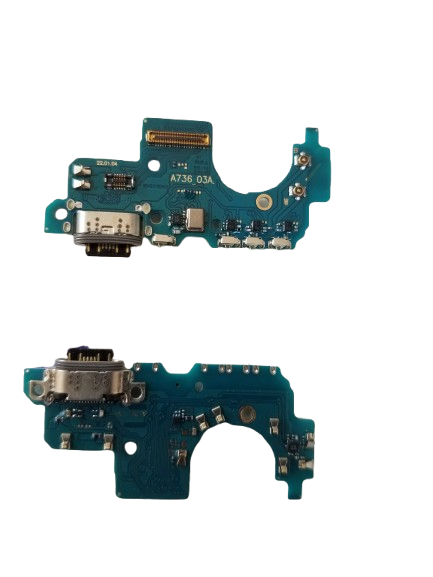
The charging board of the Samsung Galaxy A73, like most modern smartphones, is a critical component for managing power input, charging, and possibly other functions like data transfer and headphone output. The charging board may also be referred to as the charging port board or the power input board. Here is a breakdown of the parts and components typically found on the charging board of the Samsung A73:
1. USB Type-C Port
- Function: This is the main interface for charging the device. The USB Type-C port allows for fast charging and is used for data transfer when the phone is connected to a computer or another device.
- Details: The Type-C port provides a reversible design, so it can be plugged in either way.
2. Charging IC (Integrated Circuit)
- Function: This component regulates the incoming voltage and current from the charger to ensure that the phone’s battery is charged safely and efficiently.
- Details: It monitors the charging process and ensures that the battery does not overcharge or overheat, thus extending the life of the battery.
3. PCB (Printed Circuit Board)
- Function: The PCB is the base of the charging board and connects all the components. It enables the electrical signals and power to flow between the charging port, charging IC, and other connected components.
- Details: The PCB is typically a multi-layer board, with each layer serving different functions, such as power distribution, signal management, and heat dissipation.
4. Diodes and Fuses
- Function: These are used for protecting the device from power surges, short circuits, or other electrical faults. The diode prevents the reverse flow of electricity, while the fuse acts as a safeguard, blowing when there is a current overload to prevent damage to the device.
- Details: They ensure that the phone’s internal components, especially the charging circuit, are not damaged by external electrical issues.
5. Capacitors
- Function: Capacitors are used to smooth out fluctuations in the power supply, ensuring stable charging.
- Details: They store and release electrical energy when necessary to maintain a stable voltage level and protect sensitive components.
6. Inductors
- Function: Inductors are used for filtering and stabilizing the current. They help in preventing electrical noise and maintaining smooth power delivery to the battery.
- Details: These are often used in conjunction with the charging IC for efficient charging.
7. Microphone and Audio Jack (if integrated)
- Function: On some charging boards, a microphone and/or audio jack can be integrated into the same board. The microphone is used for voice recognition or calls, and the audio jack may be used for wired headphones (if the phone still supports one).
- Details: In the case of the A73, it is likely that the microphone is integrated into the charging port assembly.
8. Vibration Motor (Optional)
- Function: Some devices use small motors on the charging board for haptic feedback (vibrations).
- Details: This could be located near the charging port for additional feedback during interactions such as notifications or when the phone is in use.
9. LED Indicator (Optional)
- Function: Some devices have an LED indicator near the charging port to show the charging status (e.g., charging, fully charged, or error).
- Details: This indicator can change color depending on the charging status.
10. Heat Sink/Heat Dissipation Components
- Function: To ensure that the charging process does not overheat the phone, heat sinks or other heat-dissipating materials are used to manage temperature.
- Details: These components ensure that heat from charging does not damage internal components.
11. Data Lines (For Data Transfer)
- Function: These are the wires or traces used to transfer data between the phone and a connected device when using the charging port.
- Details: They are part of the USB Type-C interface and are responsible for communication when the phone is connected to a computer for file transfers.
In summary, the charging board of the Samsung A73 is a complex assembly that incorporates several electrical components to handle charging, power regulation, data transfer, and other essential functions. The most important parts include the USB Type-C port, charging IC, capacitors, diodes, and the PCB, all of which work together to provide efficient, safe, and reliable charging.